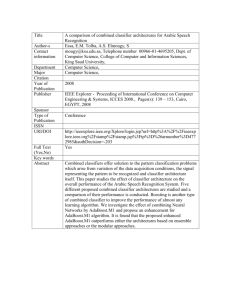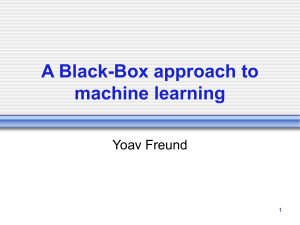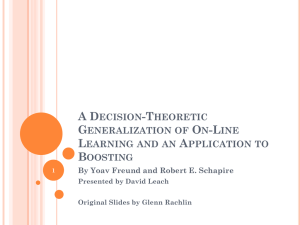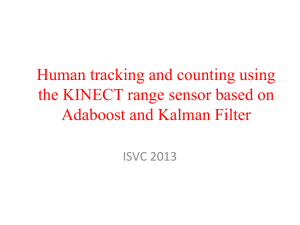Adaboost - Derek Hoiem
advertisement
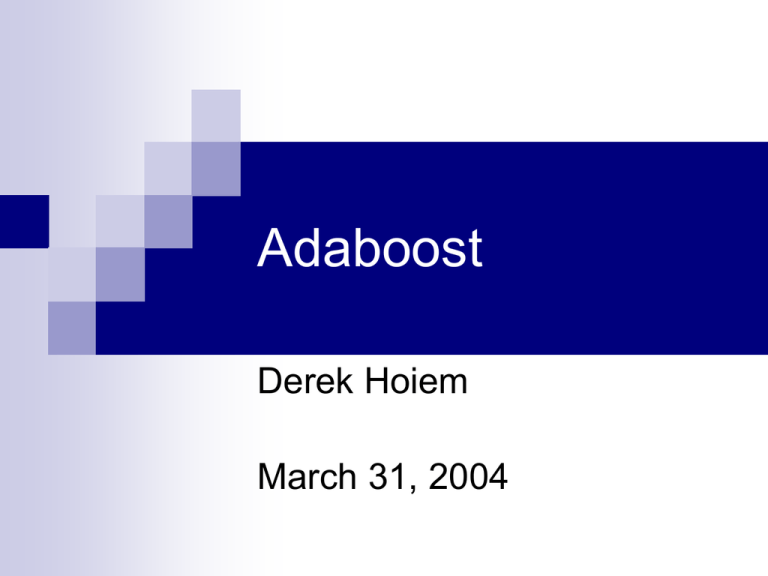
Adaboost
Derek Hoiem
March 31, 2004
Outline
Background
Adaboost Algorithm
Theory/Interpretations
Practical Issues
Face detection experiments
What’s So Good About Adaboost
Improves classification accuracy
Can be used with many different classifiers
Commonly used in many areas
Simple to implement
Not prone to overfitting
A Brief History
Bootstrapping
Bagging
Boosting (Schapire 1989)
Adaboost (Schapire 1995)
Bootstrap Estimation
Repeatedly draw n samples from D
For each set of samples, estimate a
statistic
The bootstrap estimate is the mean of the
individual estimates
Used to estimate a statistic (parameter)
and its variance
Bagging - Aggregate Bootstrapping
For i = 1 .. M
n*<n samples from D with replacement
Learn classifier Ci
Draw
Final classifier is a vote of C1 .. CM
Increases classifier stability/reduces
variance
Boosting (Schapire 1989)
Randomly select n1 < n samples from D without replacement to
obtain D1
Select n2 < n samples from D with half of the samples misclassified
by C1 to obtain D2
Train weak learner C2
Select all samples from D that C1 and C2 disagree on
Train weak learner C1
Train weak learner C3
Final classifier is vote of weak learners
Adaboost - Adaptive Boosting
Instead of sampling, re-weight
Previous
weak learner has only 50% accuracy over
new distribution
Can be used to learn weak classifiers
Final classification based on weighted vote of
weak classifiers
Adaboost Terms
Learner = Hypothesis = Classifier
Weak Learner: < 50% error over any
distribution
Strong Classifier: thresholded linear
combination of weak learner outputs
Discrete Adaboost (DiscreteAB)
(Friedman’s wording)
Discrete Adaboost (DiscreteAB)
(Freund and Schapire’s wording)
Adaboost with Confidence
Weighted Predictions (RealAB)
Comparison
2 Node Trees
Bound on Training Error (Schapire)
Finding a weak hypothesis
Train classifier (as usual) on weighted training data
Some weak learners can minimize Z by gradient descent
Sometimes we can ignore alpha (when the weak learner
output can be freely scaled)
Choosing Alpha
Choose alpha to minimize Z
Results in 50% error rate in latest weak learner
In general, compute numerically
Special Case
Domain-partitioning weak hypothesis (e.g. decision trees,
histograms)
x
x x P3
x x
o
x
o o
x o o
o
P
P1
2
Wx1 = 5/13, Wo1 = 0/13
Wx2 = 1/13, Wo2 = 2/13
Wx3 = 1/13, Wo3 = 4/13
Z = 2 (0 + sqrt(2)/13 + 2/13) = .525
Smoothing Predictions
Equivalent to adding prior in partitioning case
Confidence bound by
Justification for the Error Function
Adaboost minimizes:
Provides a differentiable upper bound on training error
(Shapire)
Minimizing J(F) is equivalent up to 2nd order Taylor
expansion about F = 0 to maximizing expected binomial
log-likelihood (Friedman)
Probabilistic Interpretation
(Friedman)
Proof:
Misinterpretations of the
Probabilistic Interpretation
Lemma 1 applies to the true distribution
Only
applies to the training set
Note that P(y|x) = {0, 1} for the training set in most
cases
Adaboost will converge to the global minimum
process local minimum
Complexity of strong learner limited by complexities of
weak learners
Greedy
Example of Joint Distribution that Cannot Be
Learned with Naïve Weak Learners
0, 0
o
0, 1
P(o | 0,0) = 1
x
P(x | 0,1) = 1
x1
x
P(o | 1,1) = 1
o
1, 0
P(x | 1,0) = 1
1, 1
x2
H(x1,x2) = a*x1 + b*(1-x1) + c*x2 + d*(1-x2) = (a-b)*x1 + (c-d)*x2 + (b+d)
Linear decision for non-linear problem when
using naïve weak learners
Immunity to Overfitting?
Adaboost as Logistic Regression
(Friedman)
Additive Logistic Regression: Fitting class conditional probability log
ratio with additive terms
DiscreteAB builds an additive logistic regression model via Newtonlike updates for minimizing
RealAB fits an additive logistic regression model by stage-wise and
approximate optimization of
Even after training error reaches zero, AB produces a “purer”
solution probabilistically
Adaboost as Margin Maximization
(Schapire)
Bound on Generalization Error
VC dimension
Confidence of correct decision
Confidence Margin
To loose to be of
practical value:
Number of training
examples
1/2
1/4
Bound confidence term
1/8
1/20
Maximizing the margin…
But Adaboost doesn’t necessarily maximize the margin
on the test set (Ratsch)
Ratsch proposes an algorithm (Adaboost*) that does so
Adaboost and Noisy Data
Examples with the largest gap between the label and the
classifier prediction get the most weight
What if the label is wrong?
Opitz: Synthetic data with 20% one-sided noisy labeling
Number of Networks in Ensemble
WeightBoost (Jin)
Uses input-dependent weighting factors for weak
learners
Text Categorization
BrownBoost (Freund)
Non-monotonic weighting function
Examples far from boundary decrease in weight
Set a target error rate – algorithm attempts to achieve
that error rate
No results posted (ever)
Adaboost Variants Proposed By
Friedman
LogitBoost
Solves
Requires
care to avoid numerical problems
GentleBoost
Update is fm(x) = P(y=1 | x) – P(y=0 | x) instead of
Bounded [0 1]
Comparison (Friedman)
Synthetic, non-additive decision boundary
Complexity of Weak Learner
Complexity of strong classifier limited by
complexities of weak learners
Example:
Learner: stubs WL DimVC = 2
Input space: RN Strong DimVC = N+1
N+1 partitions can have arbitrary confidences
assigned
Weak
Complexity of the Weak Learner
Complexity of the Weak Learner
Non-Additive Decision Boundary
Adaboost in Face Detection
Detector
Adaboost
Variant
Weak
Learner
Viola-Jones
DiscreteAB
Stubs
FloatBoost
FloatBoost
1-D Histograms
KLBoost
KLBoost
1-D Histograms
Schneiderman
RealAB
One Group of
N-D Histograms
Boosted Trees – Face Detection
Stubs (2 Nodes)
8 Nodes
Boosted Trees – Face Detection
Ten Stubs vs. One 20 Node
2, 8, and 20 Nodes
Boosted Trees vs. Bayes Net
FloatBoost (Li)
FP Rate at 95.5% Det Rate
80.0%
75.0%
70.0%
Trees - 20 bins
(L1+L2)
65.0%
60.0%
Trees - 20 bins
(L2)
55.0%
Trees - 8 bins (L2)
50.0%
Trees - 2 bins (L2)
45.0%
40.0%
35.0%
5
10
15
20
25
Num Iterations
1. Less greedy approach (FloatBoost) yields better results
2. Stubs are not sufficient for vision
30
When to Use Adaboost
Give it a try for any classification problem
Be wary if using noisy/unlabeled data
How to Use Adaboost
Start with RealAB (easy to implement)
Possibly try a variant, such as FloatBoost, WeightBoost,
or LogitBoost
Try varying the complexity of the weak learner
Try forming the weak learner to minimize Z (or some
similar goal)
Conclusion
Adaboost can improve classifier accuracy
for many problems
Complexity of weak learner is important
Alternative boosting algorithms exist to
deal with many of Adaboost’s problems
References
Duda, Hart, ect – Pattern Classification
Freund – “An adaptive version of the boost by majority algorithm”
Freund – “Experiments with a new boosting algorithm”
Freund, Schapire – “A decision-theoretic generalization of on-line learning and an application to boosting”
Friedman, Hastie, etc – “Additive Logistic Regression: A Statistical View of Boosting”
Jin, Liu, etc (CMU) – “A New Boosting Algorithm Using Input-Dependent Regularizer”
Li, Zhang, etc – “Floatboost Learning for Classification”
Opitz, Maclin – “Popular Ensemble Methods: An Empirical Study”
Ratsch, Warmuth – “Efficient Margin Maximization with Boosting”
Schapire, Freund, etc – “Boosting the Margin: A New Explanation for the Effectiveness of Voting Methods”
Schapire, Singer – “Improved Boosting Algorithms Using Confidence-Weighted Predictions”
Schapire – “The Boosting Approach to Machine Learning: An overview”
Zhang, Li, etc – “Multi-view Face Detection with Floatboost”
Adaboost Variants Proposed By
Friedman
LogitBoost
Adaboost Variants Proposed By
Friedman
GentleBoost

